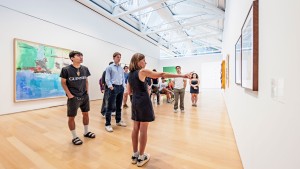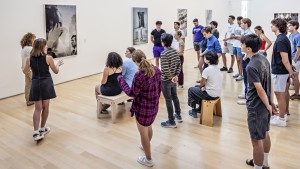Kovach is assisted in this work by Diana Flatto, whose role as the inaugural postdoctoral fellow in museum practices and scholarly engagements at The Gund also was created to support these growing partnerships.
The two pour over the course catalog looking for possible points of contact between upcoming classes and the museum’s collection and its rotating exhibitions. Then they propose ways that students might expand on what they’re learning in class.
The results are impressively widespread. During a single week in September, The Gund and its satellite in Mount Vernon, The Annex, hosted 10 different Kenyon classes studying subjects as diverse as public policy; dance; Baroque art; Arabic; American Modernism; modern Germany; 18th century novels; and environmental studies.
“The Gund is becoming more and more of a place where faculty see an opportunity to try something new in their teaching, to explore something related to their field of research that they couldn’t do elsewhere,” Kovach said. “We really think about this as a place for teaching and learning and collaboration.”
Kovach said that a class’s interaction with art can span different approaches and goals. A biology class might visit to hone students’ observation skills while an English class may use art that complements the literature they’ve been reading as writing prompts.
Ruth Heindel, the Dorothy and Thomas Jegla Assistant Professor of Environmental Studies, said her interactions with The Gund — always well organized and executed — create important, alternative ways to connect with the material.
“It allows a student a way into the content through a different angle,” she said.
She took her “Introduction to Environmental Studies” class to the gallery to look at black-and-white photographs from Appalachia on Sept. 24. The group’s interaction with the exhibition, “Milton and Anne Rogovin: A Labor of Love,” came after students learned about coal formation and extraction.
“I really wanted to bring in the social aspect of: What is a coal mining community? What are the social implications of a transition away from coal mining?” Heindel said. “A lot of those photographs are very stark portraits of coal miners and families looking straight at the camera, and I think just seeing those faces helped put a lot of this into a human perspective rather than topics that can feel distant and theoretical.”
Every single exhibit at The Gund can be used in a multitude of ways, and that’s no accident. Each is designed to connect with at least five different disciplines, Kovach said.
Consider the current weaving exhibit, “Claudia Alarcón & Silät: Everyday Anew.” In addition to Giblin’s physics seminar, it’s been used by an international studies class to consider textiles in relation to contemporary art systems and economics, and it informed a classics class’s discussion of patterns in ancient mosaics.
Giblin and Associate Professor of Physics Madeline Wade both have made visits to The Gund a regular practice for students in their first-year physics courses to help them work collaboratively, think innovatively and even form a stronger community.
“One of the beauties of our students is that they have such diverse skill sets, and I find that when we go to the gallery, they end up bringing out different parts of themselves,” Wade said. “I think that has helped students appreciate each other and build community on a higher level.”
When Adah Westphal ’29 signed up for both professors’ classes, she never dreamed that one of her first lessons would take place at the campus art museum. But she’s so glad that it did.
“I would’ve never expected coming into college — in my first two weeks of my physics class — to go to an art gallery and talk about it for hours with people,” said Westphal, who is a painter herself. “It made me think about things differently.”

